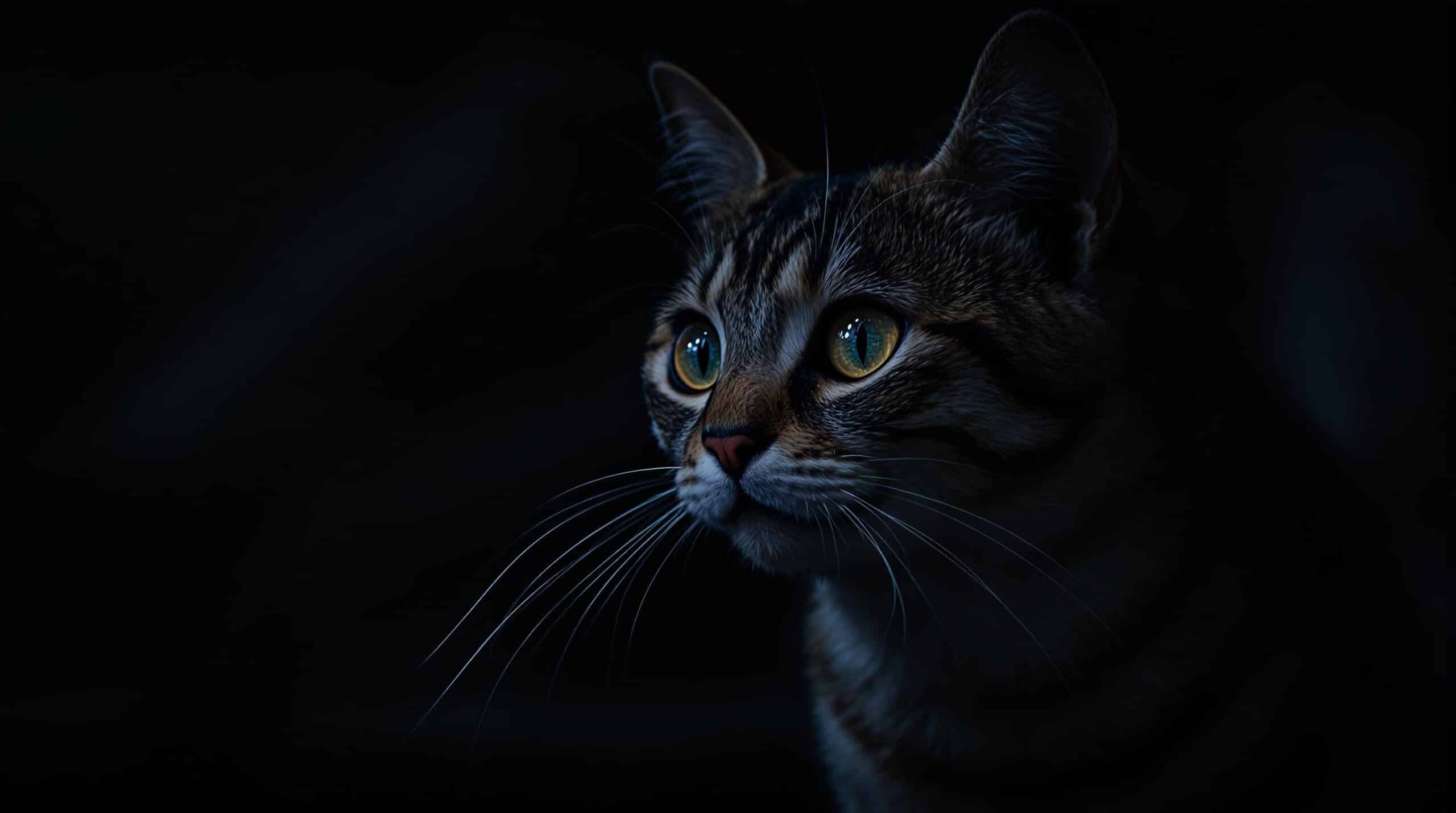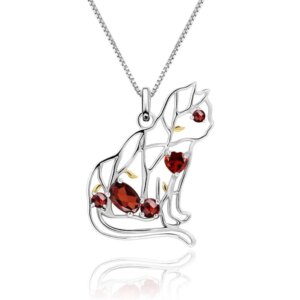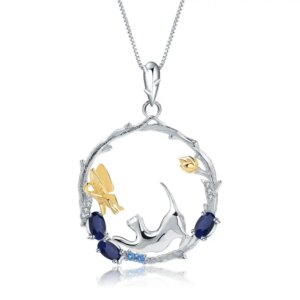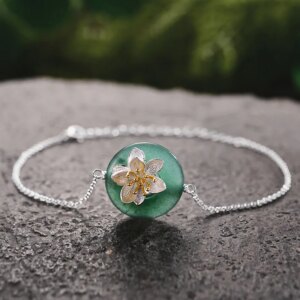Cats night vision is a trait that has fascinated humans for centuries. We at Cat Karma Creations delve into the unique eye structure and adaptations that allow cats to see in low light conditions, the science behind their night vision, and how it benefits both pet owners and their feline companions. By the end of this article, you will have a deeper understanding of why cats are such skilled nocturnal hunters and how to ensure their eye health. Visit our website to explore our range of cat-themed jewelry and gifts, perfect for any cat lover.
The Unique Structure of Cat Eyes
The ability of cats to see in the dark is largely due to the unique structure of their eyes. This section will explore the key components that contribute to their superior night vision.
The Role of the Tapetum Lucidum
The tapetum lucidum is a reflective layer located behind the retina in the eyes of cats. This layer acts like a mirror, reflecting light back through the retina a second time. This double exposure to light allows cats to see in very low light conditions, which is crucial for their nocturnal hunting activities. The tapetum lucidum is also responsible for the glowing appearance of cat eyes in the dark, a phenomenon known as eyeshine.
While humans and some other animals do not have a tapetum lucidum, it is common in nocturnal animals such as cats, dogs, and owls. This adaptation is a key factor in their ability to navigate and hunt effectively at night.
Pupil Dilation and Light Capture
Cats’ eyes have another remarkable feature: the ability to dilate their pupils significantly. This dilation allows their eyes to capture more light, further enhancing their night vision. The pupils of cats can expand to cover almost the entire eye surface, which is much more extensive than the dilation capabilities of human eyes.
When a cat is in a dark environment, its pupils will dilate to their maximum size, allowing as much light as possible to enter the eye. This increased light capture, combined with the tapetum lucidum, gives cats an incredible advantage in low light conditions.
Cornea and Lens Adaptations
The cornea and lens of a cat’s eye are also adapted to enhance night vision. The cornea is the clear, dome-shaped surface at the front of the eye, and it helps to focus light onto the retina. In cats, the cornea is relatively large and curved, which allows it to capture more light and focus it more effectively.
The lens, located behind the cornea, works in conjunction with the cornea to focus light onto the retina. In cats, the lens is also adapted to function well in low light conditions. Together, these adaptations ensure that cats can see clearly and accurately in the dark, making them formidable night hunters.
Comparing Cat Night Vision to Other Animals
While cats are known for their exceptional night vision, it is interesting to compare their capabilities to those of other animals. This section will explore how cats’ night vision stacks up against that of dogs, humans, and owls.
Dogs: Similarities and Differences
Dogs, like cats, also have a tapetum lucidum, which helps them see in low light conditions. However, the night vision of dogs is generally considered to be less advanced than that of cats. While both animals have the ability to dilate their pupils significantly, cats’ eyes are more adapted to capturing and processing light.
One key difference is the size of the tapetum lucidum in dogs compared to cats. In dogs, this layer is less reflective, which means they do not have the same level of light amplification as cats. Additionally, the overall structure of the eye in dogs is slightly different, which can affect their ability to see in very low light conditions.
Humans: Limitations and Advantages
Humans, unlike cats and dogs, do not have a tapetum lucidum. This means that our night vision is significantly less advanced. The human eye is adapted to see in a wide range of light conditions, but it is not optimized for low light environments. While humans can see in dim light, they do not have the same level of sensitivity to light as cats.
One advantage of human vision is our ability to see a wide range of colors. Cats, on the other hand, have dichromatic vision, which means they can see only two primary colors (blue and green). However, this color vision is less important for nocturnal activities, where the ability to see in low light is more crucial.
Owls: Exceptional Night Vision
Owls are often considered the kings of night vision among animals. Like cats, owls have a tapetum lucidum and the ability to dilate their pupils significantly. However, the eyes of owls are even more adapted to low light conditions. Owls have a higher density of rod cells in their retina, which are responsible for detecting light and movement in low light environments.
The large size of owl eyes, relative to their body size, also contributes to their exceptional night vision. This combination of adaptations allows owls to see in extremely low light conditions, making them one of the most effective nocturnal hunters in the animal kingdom.
Evolutionary Adaptations for Night Vision
The night vision capabilities of cats are not just a result of their current anatomy but are the product of millions of years of evolutionary adaptation. This section will explore how these adaptations have developed over time and the benefits they provide.
Historical Development of Night Vision
The ancestors of modern cats were primarily nocturnal hunters, and their night vision capabilities evolved to help them survive in low light environments. Over time, natural selection favored individuals with better night vision, leading to the development of the unique eye structures we see in cats today.
The tapetum lucidum, for example, is an adaptation that has been refined over millions of years. This layer is present in many nocturnal animals, but it is particularly well-developed in cats. The ability to dilate pupils and the adaptations in the cornea and lens are also the result of evolutionary pressures that favored individuals with these traits.
Survival Benefits of Night Vision
The night vision capabilities of cats provide several survival benefits. One of the most significant advantages is the ability to hunt effectively at night. Nocturnal predators like cats have a better chance of catching prey that is active during the night, as their prey is less likely to detect them.
Additionally, night vision allows cats to avoid predators that are active during the day. By being active at night, cats can reduce the risk of encountering larger predators that hunt during the day. This adaptation has been crucial for the survival and success of cats in the wild.
Behavioral Impacts of Night Vision
The night vision capabilities of cats have also influenced their behavior and lifestyle. Cats are naturally crepuscular, meaning they are most active during the twilight hours of dawn and dusk. This activity pattern is closely tied to their night vision, as these times provide the optimal light conditions for their hunting activities.
In domestic settings, cats often exhibit behaviors that are influenced by their night vision. For example, they may be more active at night and may show increased interest in playing or exploring during these hours. Understanding these behaviors can help pet owners better cater to their cats’ needs and provide a more enriching environment.
Maintaining Your Cat’s Eye Health
While cats have remarkable night vision, it is important to maintain their eye health to ensure this ability remains strong. This section will provide tips for keeping your cat’s eyes healthy and functioning optimally.
Regular Eye Check-Ups
Regular check-ups with a veterinarian are essential for maintaining your cat’s eye health. During these check-ups, the vet can examine your cat’s eyes for any signs of problems, such as cloudiness, redness, or discharge. Early detection of eye issues can help prevent more serious conditions from developing.
It is recommended to schedule an eye check-up at least once a year, or more frequently if your cat has a history of eye problems. If you notice any changes in your cat’s eyes or behavior, it is important to consult a vet as soon as possible. You can also explore our cat-themed jewelry and gifts to show your love for your feline friend.
Diet and Nutrition for Eye Health
A balanced diet is crucial for maintaining your cat’s overall health, including their eyes. Certain nutrients, such as vitamins A and E, are particularly important for eye health. Vitamin A is essential for the production of rhodopsin, a pigment in the retina that helps with night vision. Vitamin E is an antioxidant that can protect the eyes from damage caused by free radicals.
Feeding your cat a high-quality, balanced diet that includes these essential nutrients can help support their eye health. You can also consider adding supplements to their diet, but it is important to consult with a veterinarian before doing so. For more information, visit our website or follow us on Facebook and Instagram.
Signs of Eye Problems to Watch For
Being aware of the signs of eye problems can help you catch issues early and ensure your cat receives the necessary treatment. Some common signs to watch for include:
- Redness or swelling of the eyes
- Excessive tearing or discharge
- Squinting or rubbing the eyes
- Cloudiness or changes in the appearance of the eyes
- Difficulty seeing or bumping into objects
If you notice any of these signs, it is important to seek veterinary care as soon as possible. Early intervention can often prevent more serious eye conditions from developing. For more tips and insights, visit our website or contact us at (800) 343-1604 or info@catkarmacreations.com.
Popular Quote
“Cats are a mysterious kind of folk. There is more passing in their minds than we are aware of.” – Agatha Christie
Statistical Fact
According to a study by the American Veterinary Medical Association, approximately 70% of cats over the age of 3 have some form of eye disease. This statistic underscores the importance of regular eye check-ups and maintaining your cat’s eye health. (Source: American Veterinary Medical Association)
Three Tips for Enhancing Your Cat’s Night Vision
1. Provide a Dark Environment
Ensure that your cat has access to a dark, quiet space where they can rest and play during the night. This can help them feel more comfortable and secure, which is important for their overall well-being and night vision.
2. Use Night-Lights Strategically
While cats can see in very low light, a dim night-light can help them navigate their environment more easily. Place a night-light in areas where your cat frequently moves around at night, such as near their food and water bowls or their litter box.
3. Encourage Nighttime Play
Engaging your cat in play during the evening can help stimulate their natural hunting instincts and enhance their night vision. Use toys that mimic prey, such as feather wands or laser pointers, to keep them active and engaged.
Popular Questions
1. Why do cats’ eyes glow in the dark?
The glowing appearance of cats’ eyes in the dark, known as eyeshine, is caused by the tapetum lucidum, a reflective layer behind the retina. This layer reflects light back through the retina, enhancing the cat’s ability to see in low light conditions.
2. Can cats see in complete darkness?
Cats cannot see in complete darkness, but they can see in very low light conditions. Their eyes are adapted to capture and process even the slightest amount of light, which allows them to navigate and hunt effectively at night.
3. How can I tell if my cat has an eye problem?
Common signs of eye problems in cats include redness, swelling, excessive tearing or discharge, squinting, rubbing the eyes, cloudiness, and difficulty seeing. If you notice any of these signs, it is important to consult a veterinarian as soon as possible.
Final Thoughts
Cats’ night vision is a remarkable adaptation that has evolved over millions of years, allowing them to thrive in low light conditions. Understanding this unique ability can help pet owners appreciate their cats’ natural instincts and ensure their eye health. By providing regular check-ups and a balanced diet, you can help your feline friend maintain their exceptional night vision. Visit our website to explore our range of cat-themed jewelry and gifts, perfect for any cat lover. If you have any questions or would like to place a custom order, feel free to contact us at (800) 343-1604 or info@catkarmacreations.com.

















